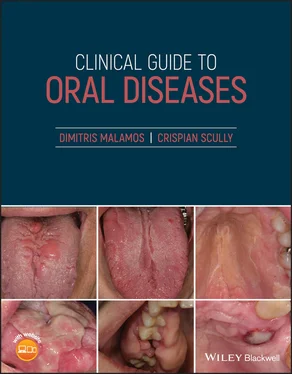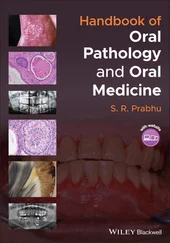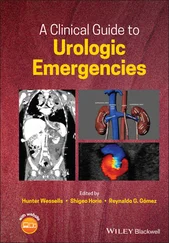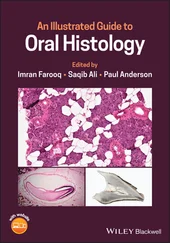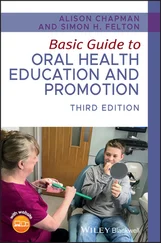PMH: No serious medical problems were recorded apart from an episode of severe pneumonia which was diagnosed last December and was treated with a strong course of antibiotics. No other drugs were taken, but the patient was a smoker (>40 cigarettes, daily) and a drinker (4–5 glasses of wine or relevant spirit per meal).
OE: The examination revealed an asymptomatic white lesion on the floor of mouth extended from the left lower premolar to the molar region. The lesion was fixed in palpation and had a warty‐like surface with two to three bleeding areas ( Figure 1.5). Smoking‐induced lesions such as increased gingival pigmentation, nicotinic stomatitis and brown teeth discoloration were also found, together with ipsilateral, fixed, enlarged cervical lymph nodes where oral or skin petechiae and ecchymoses were not seen.
Q1What is the cause of bleeding?
1 Traumatic ulceration
2 Pemphigus vegetans
3 Verrucous leukoplakia
4 Giant verruca vulgaris
5 Squamous carcinoma
Answers:
1 No
2 No
3 No
4 No
5 Squamous cell carcinoma is the cause of his oral bleeding. This tumor is a locally aggressive, tumor which appears as an indurated swelling, ulceration or plaque of various cellular differentiation and risk of metastasis. This lesion grows either slowly and superficially, but in majority of cases grows fast and invades deep tissues such as muscles and blood vessels causing muscle dysfunction and bleeding.
Comments: This tumor differs from other vegetating oral lesions such as hyperplastic traumatic ulcerations, pemphigus vegetans, verrucous leucoplakia, and verrucous vulgaris. The lack of local trauma or other vegetating lesions in the flexures of the patient rules out traumatic ulceration and pemphigus vegetans from the diagnosis, while the hard consistency and strong fixation of the lesion with the underling tissues is not an indication of verrucous vulgaris and leukoplakia where biopsy is required.
Q2Although the verrucous carcinoma is a variation of oral carcinomas, it differs from the other types in the following histological characteristics:
1 Evidence of dysplasia in adjacent epithelium
2 Shape of the rete pegs
3 Absence of keratinization
4 Location of mitosis
5 Basal basement membrane status
Answers:
1 Dysplastic epithelium is often seen close to the oral squamous, but not to verrucous carcinomas.
2 The shape of rete pegs entering the corium is variable in the majority of oral carcinomas, but is bulbous, like elephant feet in verrucous carcinoma.
3 No
4 In oral carcinomas, the mitoses are scattered in the basal and spinous layer, while in verrucous carcinoma they are located mainly in the basal layer.
5 In oral carcinomas the basal membrane is invaded by tumor islands, but in verrucous carcinoma it is intact and the tumor grows superficially as well.
Comments: Keratinization is commonly seen in both tumors; however keratin pearls are mainly found in squamous carcinoma, while keratin plugs are found in verrucous carcinomas.
Q3Which of the measures below is/are not amenable to control bleeding from an oral carcinoma?
1 Identification of the underlying cause of oral bleeding
2 Blood investigations
3 Packing‐dressing
4 Suturing
5 Radiotherapy
Answers:
1 No
2 No
3 No
4 No
5 Radiotherapy is sometimes useful to the control of excessive bleeding that may arise from lung but not oral carcinomas. Patients with oral carcinomas and other head and neck tumors have already received the maximum dose of radiotherapy when bleeding begins, and therefore other aggressive measures such as arterial embolization should be undertaken.
Comments: Clinicians must control oral bleeding by following some basic steps such as the identification of the causative factor by taking a comprehensive history and careful clinical examination; excluding bleeding diseases by checking white blood count and clotting profiles as well as packing or dressing with hemostatic agents, while in more severe cases with cauterization, suturing, or embolization should be used.
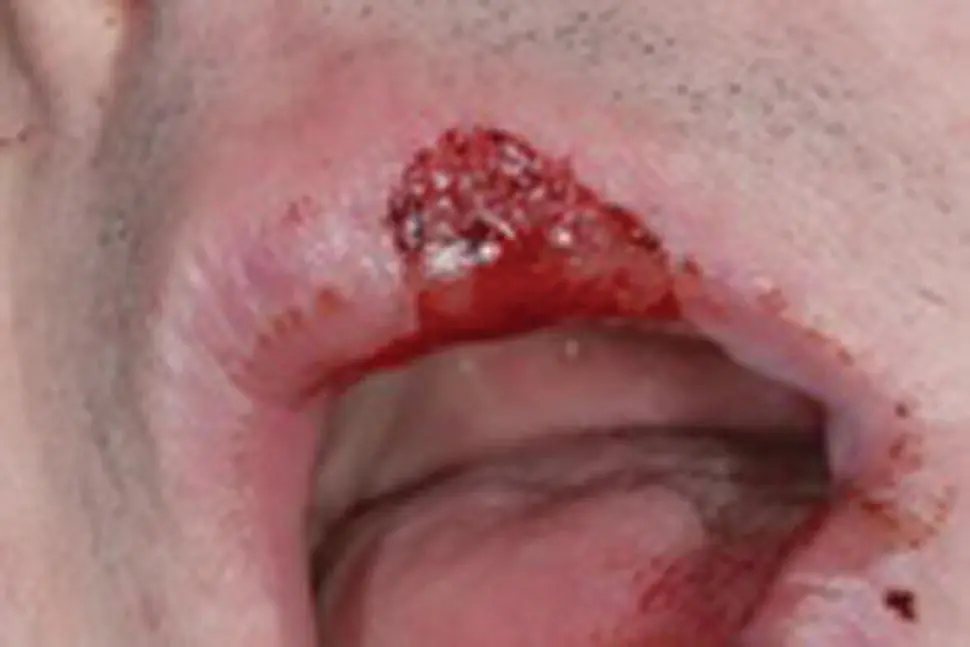
Figure 1.6a
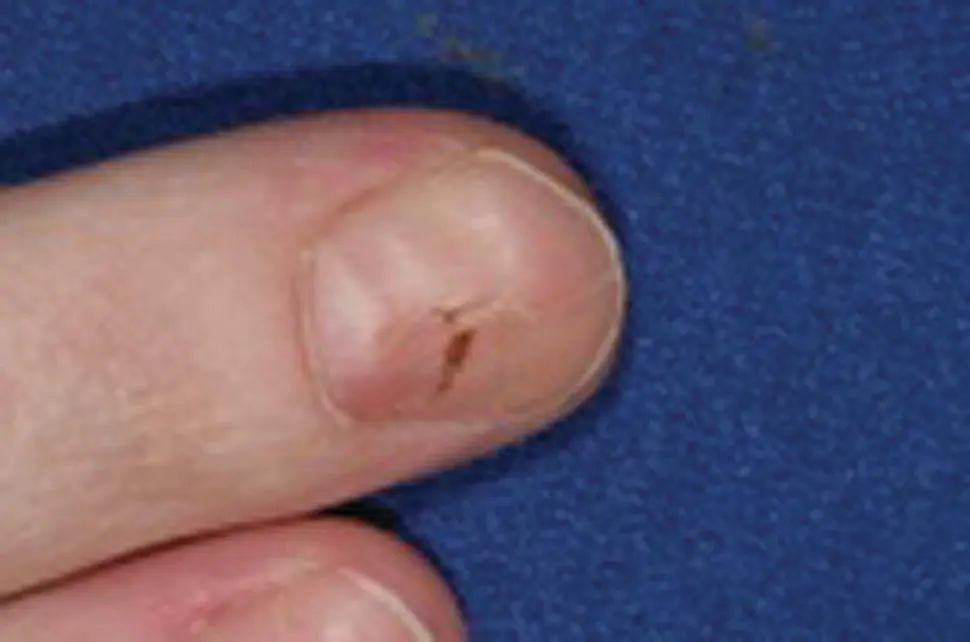
Figure 1.6b
CO: A 24‐year‐old male was referred for an evaluation of bleeding from his upper lip.
HPC: The hemorrhage appeared on his upper lip during eating from a broken bulla three hours ago.
PMH: This young man suffers from Down syndrome and over the last two years he has been complaining about multiple bullae on the skin of his legs, mouth, and genitals. He had a short course of steroid cream for skin bullae which was not effective, causing him to refuse any other medications since then.
OE: An anxious young man, showing numerous ulcerations inside his mouth, lips, and legs as a result of ruptured bullae due to friction. A hemorrhagic ulceration on his upper lip ( Figure 1.6a) together with a tiny hemorrhage of the nail bed of his middle finger was found ( Figure 1.6b). No other hemorrhagic lesions (petechiae or ecchymoses) were seen inside his mouth, skin or other mucosae. On the other hand, epistaxis was not referred and general symptomatology was absent. The patient was admitted to an examination, and blood results revealed no clotting disorders while biopsy of the skin revealed a subepithelial bulla with positive immunofluorescence of IgG and C3 along the basement membrane zone (BMZ).
Q1What is the cause of his lip bleeding?
1 Self‐induced lip trauma
2 Pemphigoid disorders
3 Clotting disorder
4 Erythema multiforme
5 Herpetic stomatitis
Answers:
1 No
2 Pemphigoid bullous diseases (mucous and bullous) are a group of subepithelial bullous disorders which affect mainly the mouth (mucous type; or less frequently bullous type) or the skin. They have a characteristic immunofluorescence profile. Their bullae break easily and leave painful hemorrhagic ulcerations covered with hemorrhagic crusts as seen in this patient.
3 No
4 No
5 No
Comments: Clotting disorders are easily excluded from the diagnosis as the blood tests were negative. Herpetic stomatitis causes similar hemorrhagic oral lesions but is ruled out as this condition lacks chronic skin lesions and its severe mouth lesions occur only once and not constantly, as seen in this patient. Erythema multiforme shows similar findings with the patient's lesions, but is also excluded due to the short duration of its lesions and presence of fibrin instead of IgG and C 3with BMZ. Factitious illness is a problem in the disabled but not in Down syndrome patients, as these are less likely to develop maladaptive behavior and the patient did not show any aggressive behavior capable of causing self‐induced lesions in his body.
Q2Which of the bullous disorders is/or are initiated with urticarial skin lesions?
1 Pemphigus vulgaris
2 Bullous pemphigoid
3 Cicatricial pemphigoid
4 Paraneoplastic pemphigus
5 Dermatitis herpetiformis
Answers:
1 No
2 Bullous pemphigoid is a chronic subepithelial blistering disease that starts as an urticarial eruption which develops large firm bullae, especially in flexor skin areas over a course of weeks to months.
Читать дальше
